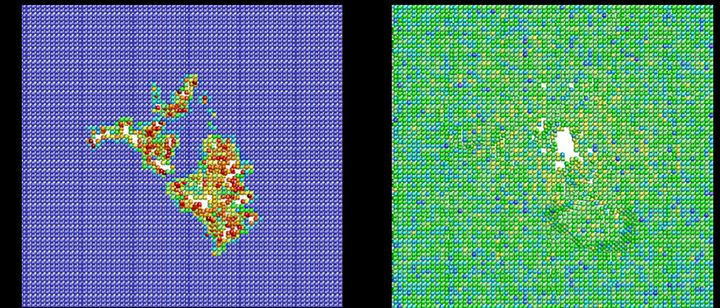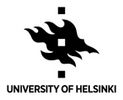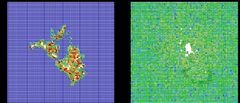Reconsidering damage production and radiation mixing in materials

Understanding the nature of radiation damage in materials is of paramount importance for controlling the safety of nuclear reactors, using ion implantation in semiconductor technology, and designing reliable devices in space.
The standard approach to estimating the radiation damage in materials analytically has been for more than 60 years a simple equation, known as “Kinchin-Pease”. However, the so called “displacements-per-atom” (dpa) number obtained from this equation does not in common metals usually correspond to any physically measurable quantity. This was established experimentally about 40 years ago, and computer simulations carried out during the last 25 years have firmly established the physical reason to this.
“The explanation is, in brief, that in metals, irradiation produces on picosecond time scales a liquid-like zone, which during the cooling-down phase recombines much of the initially produced damage, leading to a factor of 1/3 reduction in damage”, says Professor Kai Nordlund who was in lead of the team on search for more accurate predictions of usability of materials in nuclear environments, that now present their results freshly in Nature Communications.
“On the other hand, the formation of the transient liquid leads to a massive amount of atoms in the crystal, about a factor of 30 more than the dpa value, being replaced by others after the liquid has cooled down”, he says.
Formulating two new equations to correct the problem
Even though these issues are well established, there has until now been no attempt to correct the problems of the standard dpa equations.
In their article “Improving atomic displacement and replacement calculations with physically realistic damage models” published in Nature Communications, the scientists present the outcome of a reconsideration of the issue. It lead to the formulation of two new equations, the “athermal recombination-corrected dpa” (arc-dpa) and the replacements-per-atom (rpa) functions, that with a minimal increase in computational complexity allows for accurate and experimentally testable predictions of damage production and radiation mixing in materials.
The researchers expect that the new equations will be a basis for formulating more reliable and efficient predictions of the usable lifetime of materials in nuclear reactors and other environments with high levels of ionizing radiation. This is especially important for formulating fusion and new kinds of fission nuclear power plants.
Source:
Improving atomic displacement and replacement calculations with physically realistic damage models, http://rdcu.be/I1kO, DOI 10.1038/s41467-018-03415-5, Nature Communications, 14.3.2018
Image by Andrea Sand, University of Helsinki
Image text:
Left: Illustration of the number of defects in materials predicted by the old “Kinchin-Pease” equation; Right: Illustration of the actual number of remaining damage, consistent with the prediction of the new model.
Contact:
Professor Kai Nordlund, University of Helsinki, +358 50 415 6815, @kai_nordlund, kai.nordlund@helsinki.fi
Keywords
Contacts
Minna Meriläinen-TenhuScience communicator
Tel:+358 50 415 0316minna.merilainen@helsinki.fiImages
About Helsingin yliopisto
 Helsingin yliopisto
Helsingin yliopistoPL 3
00014 Helsingin yliopisto
02941 22622 (mediapalvelu) 02941 911 (vaihde) (vaihde)https://www.helsinki.fi/fi/yliopisto
Helsingin yliopisto on yli 40 000 opiskelijan ja työntekijän kansainvälinen yhteisö, joka tuottaa tieteen voimalla kestävää tulevaisuutta koko maailman parhaaksi. Kansainvälisissä yliopistovertailuissa Helsingin yliopisto sijoittuu maailman parhaan yhden prosentin joukkoon. Monitieteinen yliopisto toimii neljällä kampuksella Helsingissä sekä Lahden, Mikkelin ja Seinäjoen yliopistokeskuksissa. Lisäksi sillä on kuusi tutkimusasemaa eri puolilla Suomea ja yksi Keniassa. Yliopisto on perustettu vuonna 1640.
Subscribe to releases from Helsingin yliopisto
Subscribe to all the latest releases from Helsingin yliopisto by registering your e-mail address below. You can unsubscribe at any time.
Latest releases from Helsingin yliopisto
Baarimikko voi olla urpo, mutta Urpo maailman paras baarimikko26.4.2024 07:30:00 EEST | Tiedote
Monia etunimiä käytetään arkikielessä yleisniminä: esimerkiksi stereotyyppistä teinipoikaa voidaan sanoa jonneksi ja oksennusta yrjöksi. Etunimet voivat olla myös yhdyssanan osia. Esimerkiksi sanojen lappuliisa, baarimikko ja taskumatti jälkimmäinen osa on etunimi.
Eduskuntavaalitutkimus 2023 julkistamistilaisuus 13.5. Helsingin yliopiston valtiotieteellisessä tiedekunnassa25.4.2024 11:02:23 EEST | Kutsu
Lämpimästi tervetuloa ”Pääministerivaalit polarisaation aikakaudella: Eduskuntavaalitutkimus 2023” julkistamistilaisuuteen 13.5. klo 10-12 . Nyt julkaistava eduskuntavaalitutkimuksen pääraportti on kattava teos suomalaisten äänestäjien käyttäytymisestä 2023 eduskuntavaaleissa.
Iäkkäiden lääkehoidon riskitekijöiden tunnistaminen on avainasemassa kotona asumisen tukemisessa23.4.2024 09:58:40 EEST | Tiedote
Tuoreessa väitöstutkimuksessa on kehitetty malli iäkkäiden lääkehoidon riskitekijöiden tunnistamiseksi osana laajempaa terveystarkastusta. Tutkimuksen tavoitteena oli tarjota konkreettisia keinoja iäkkäiden terveyden ja toimintakyvyn ylläpitämiseksi, jotta he voisivat asua kotona mahdollisimman pitkään.
Helsingin yliopiston operatiivinen tulos 2023 oli 16 miljoonaa euroa miinuksella17.4.2024 14:37:06 EEST | Tiedote
Varainhankinta sekä sijoitus- ja rahoitustuotot nostivat kokonaistuloksen plussalle. Yliopisto lisää sijoitustoiminnan tuotonjakoa perustehtävään seuraavien viiden vuoden ajan.
Pelastakaa tiede! -dokumenttielokuva kertoo tieteen evakuoinnin tarinan17.4.2024 10:28:01 EEST | Tiedote
Kirjailija, FT Anna Kortelainen, Kansalliskirjasto ja Kirjastokaista ovat tuottaneet yhteistyössä dokumentin, joka pureutuu Kansalliskirjaston aineistojen evakuointiin talvi- ja jatkosodan aikana. Elokuva julkaistaan 17.4.2024 Kirjastokaistan verkkosivuilla sekä Kansalliskirjaston Youtube-kanavalla.
In our pressroom you can read all our latest releases, find our press contacts, images, documents and other relevant information about us.
Visit our pressroom
